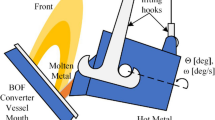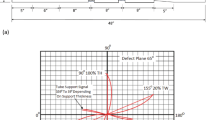Abstract
The torque control method is mainly used as a clamping method for high-strength bolts in Korea and Japan. However, the torque coefficient affects the tension that is required during the process of tightening by torque. This makes it difficult to assume the direct tension induced into the bolt. The determinant factor that affects the clamping force is the ambient temperature, as indicated by the Korean standard B 2819. This study was planned to assess the expected clamping force of two types of high-strength bolts considering a temperature range of-10 to 50°C. Based on laboratory data subjected to temperature parameters, equations to estimate the clamping force were extracted by regression analysis.
Similar content being viewed by others
References
American Institute of Steel Construction (AISC) (2001). Manual of steel construction. 3rd Ed., Vols. 1-2, Chicago.
Architectural Institute of Japan (1993), Recommendations for the Design Fabrication of High Strength Bolted Joints, AIJ.
Architectural Institute of Japan (2003). Guidebook on Design and Fabrication of High Strength Bolted Connections, AIJ, Japan.
Bickford, J. H. (1990). An Introduction to the Design and Behavior of Bolted Joints, Marcel Dekker Inc., Madison Avenue, New York, N.J., USA.
Bickford, J. H. and Nassar, S. (1998). Handbook of bolts and bolted joints, Marcel Dekker Inc., Madison Avenue, New York, N.J., USA
Dahl, J. S., Lu, L., Fisher, J. W., and Abruzzo, J. (1996). “Comparative Effectiveness of Tightening Techniques for A490 1-1/4 inch Diameter Bolts.” Engineering Journal, 33(1), pp. 7–17.
Frank, K. H. and Yura, J. A. (1981). An Experimental Study of Bolted Shear Connections, Office of Research and Development, Federal Highway Administration, Department of Transportation, Washington, D.C.
Fukuoka, T. and Takaki, T. (2004). Evaluations of the Tightening Process of Bolted Joint with Elastic Angle Control Method, Analysis of Bolted Joints, PVP. 478, pp. 11–18.
Lehmen, C. J. (2002). Direct Tension Indicators, Practical Periodical on Structural Design and Construction, pp. 48–51.
Kim, J. H. (2001). An Experimental Study on the Structural Behavior in Friction Type Bolted Joints Clamping by F13T Grade High Strength Bolt, Journal of Architectural Institute of Korea, 17(12).
Kulak, G. L. and Undershutte, S. T. (1998). “Tension Control Bolts: Strength and Installation.” Journal of Bridge Engineering, pp. 15–20.
Kulak, G. L., Fisher, J. W., and Struik, J. H. A. (2001). Guide to Design Criteria for Bolted and Riveted Joints, 2nd Edition, AISC, Inc.
Li, G. Jiang, S., Yin, Y., Chen, K., and Li, M. (2003). “Experimental Studies on the Properties of Constructional Steel at Elevated Temperatures.” Journal of Structural Engineering, pp. 1717–1721.
MINITAB Manual (2005). Ver. 14.2
MINITAB Program (2008). Ver. 15, http://www.minitab.co.kr
Nah, H. S., Kim, K. S., Lee, H. J., and Kim, W. B. (2008). “Evaluation on Clamping Force of High Strength Bolts by Temperature Parameter.” Journal of Korean Steel Structure, KSSC, 20(3), pp. 399–407.
Oswald, C. J., Dexter, R. J., and Brauer, S. K. (1996). “Field Study of Pretension in Large Diameter A490 Bolts.” Journal of Bridge Engineering, pp. 121–126.
Park, S. H. (2003), Design of Experiments, 5th Edition, Minyoung-sa, Seoul
Park, Y. M. and Song, T. R. (2000). “Experiments on Slip Coefficients of High Strength Bolt Connection with Weathering Steel (1).” Journal of Korean Steel Structure, 12(2), pp. 167–175.
RCSC committee A.l, American Institute of Steel Construction, Inc. (2000). Specification for Structural Joints Using ASTM A325 or A490 Bolts, Jun. AISC, Inc.
Tamboli, A. R. (1999). Handbook of Structural Steel Connection Design and Details. McGraw-Hill, New York, USA.
Yang, J. G. and Jeon, S. S. (2008). Analytical Models for the Initial Stiffness and Plastic Tensile Load Capacity of a Double Angle Connection Subjected to Tension, International Journal of Steel Structures, KSSC, 8(3), pp. 237–248.
Yang, J. and DeWolf, J. (1999). “Mathematical Model for Relaxation in High Strength Bolted Connections.” Journal of Structural Engineering, pp. 803–808.
Yang, J. and DeWolf, J. (2000). “Relaxation in High Strength Bolted Connections using Galvanized Steel.” Journal of Bridge Engineering, pp. 99–106.
Author information
Authors and Affiliations
Corresponding author
Rights and permissions
About this article
Cite this article
Nah, HS., Lee, HJ., Kim, KS. et al. Method for estimating the clamping force of high strength bolts subjected to temperature variation. Int J Steel Struct 9, 123–130 (2009). https://doi.org/10.1007/BF03249487
Received:
Accepted:
Issue Date:
DOI: https://doi.org/10.1007/BF03249487




